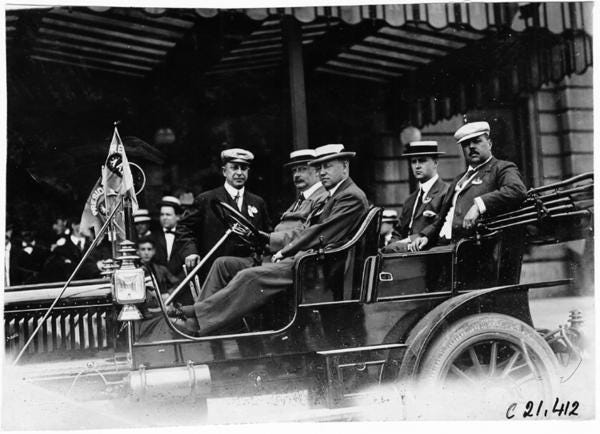The Role of the Glidden Tour
Search
Featured Article
Image of The Week
The Glidden Tour was one of the premier automobile contests of the early years of motorsport. Started in 1905, it was part of a mix of competitive events that gave a sense of purpose, organization, and vision to motorsport. Two other high-profile races came on the scene the previous year, the Vanderbilt Cup and the Ormond Beach Time Trial Tournament — which was seven miles south of Daytona.

(Above photo) The 1909 Glidden Tour. Standing beside this car is Frank B. Hower, the chairman of the American Automobile Association (AAA) contest board. AAA President L.R. Speare is at the wheel with George C. Diehle, chairman, Good Roads Committee beside him. In the back seat are L.H. Elliott and Charles J. Glidden — the founder of the event and the donator of the trophy. The Making of Modern Michigan identifies this photo as the work of Nathan Lazarnick.
Enduring automotive brands such as Mercedes, Packard, Ford, Oldsmobile, Darracq, Fiat, Renault, and Overland emerged at this time. Driving stars like Barney Oldfield, Victor Hemery, Vincenzo Lancia, Herb Lytle, Charles Basle, and J. Walter Christie established themselves as household names. Lancia and Hemery were superstars of Europe and top competitors in the Vanderbilt Cup. Hemery won it in 1905. Oldfield, Basle, and Lytle all went on to race in the Indianapolis 500.
As for the Glidden Tour, it was established by Charles Glidden, who made a fortune in the early days of the telecommunications industry. Fascinated with technology and with a head for business, he saw opportunities in the nascent automotive industry.
Glidden toured the world with his wife Lucy in a British Napier in 1902 and then participated in an American Automobile Association (AAA) touring competition in 1904. It was during this time that he made the connections with automotive men and AAA officials that inevitably led to Glidden stamping his name on what became a very famous trophy. The honor was effectively a sponsorship as Glidden drew on his abundant resources.
The original Glidden Tour endured seven years and at its zenith played to high acclaim. While competition like the Vanderbilt Cup, the Ormond Beach Tournament, the American Grand Prize and eventually the Indianapolis 500 displayed unbridled technology, and maximum speed, Mr. Glidden’s event was a different beast.
The Glidden Tour was positioned as an endurance contest with regulated speed. Drivers were expected to deliver the machines at checkpoints within a specified time window. The purpose was to demonstrate reliability, so while the cars needed reasonable speed, that was not the paramount criterion. Demerits were assessed for mechanical faults as the cars were inspected by AAA officials at control points.
The whole purpose was for manufacturers to demonstrate the quality of their products — because they were reliable, they could take punishment. There could be no doubt the machines were punished. The charted courses were designed to be challenging. They were well over 1,000 miles and covered craggy, undeveloped terrain that frequently required competitors to ford creeks.
The Glidden Tour was like a rolling industry convention. Top executives like Howard Marmon drove in the event, while many others simply rode along with professional drivers like Webb Jay and “Jap” Clemens. Others served as officials or drove and rode in cars called “Pathfinders” or “Pilots.” These were pace cars of sorts and passengers in the tonneaus (back seat with open-air body design) frequently scattered confetti out the back to help competitors stay on the charted course.
There were many such reliability runs in the day, but The Glidden was the most renown. They were particularly important in early years. Cities competed to be on the course because they saw the commercial opportunities.
If you click thru at the link below you will find a snapshot in time. Let’s take you back to February 1910 to read the news coverage of the late surge by civic leaders in Indianapolis to wrest from Cincinnati the honor of becoming the point of departure for the run. The ace up their sleeve was the new, state-of-the-art brick-paved Indianapolis Motor Speedway and the critical mass of car manufacturers in the Hoosier capital.
Moving on to 1913, automobiles as products had matured well past the introductory phase. Also, manufacturers frequently bickered with each other and complained to the AAA about any penalty their entry received.
Penalties were understandably seen as blemishes on brand reputation. The more officials tried to appease hard-headed executives, the more exhausting and pointless the whole production seemed.
The Glidden Tour was revived in 1946, not as some kind of product proving ground, but as an antique car celebration. The event continues today.
